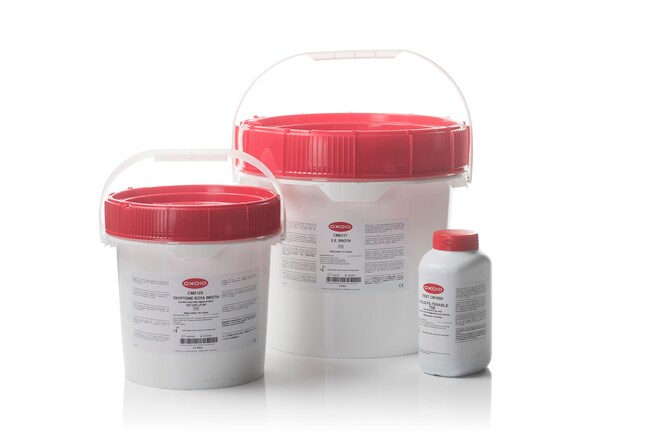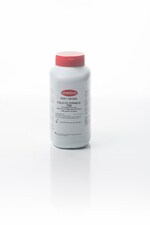Search Thermo Fisher Scientific
Thermo Scientific™
Membrane Lactose Glucoronide Agar (MLGA)
Catalog number: CM1031T




Thermo Scientific™
Membrane Lactose Glucoronide Agar (MLGA)
Catalog number: CM1031T
Detect, enumerate and differentiate Escherichia coli and other coliforms by single membrane filtration with Thermo Scientific™ Oxoid™ Membrane Lactose Glucuronide Agar (MLGA) (Dehydrated). The presence of lauryl sulphate and lactose with phenol red allow the selective isolation and differentiation of Escherichia coli and coliforms respectively.
| Description | Membrane Lactose Glucuronide Agar (MLGA)(Dehydrated) |
| Form | Powder |
| Product Type | Agar |
| Quantity | 5 kg |
| Shelf Life | 3 Years |
| Unit Size | Each |
| Description | Membrane Lactose Glucuronide Agar (MLGA)(Dehydrated) |
| Form | Powder |
| Product Type | Agar |
| Quantity | 500 g |
| Shelf Life | 3 Years |
| Unit Size | Each |
Showing 2 of 2
| Catalog Number | Specifications | Unit Size | Quantity | Price (USD) | |||||||||||||||||||||||||||||||||||||||||||||||||||||||||||||||||||||||||||||||||||||||||||||||||||||||||||
|---|---|---|---|---|---|---|---|---|---|---|---|---|---|---|---|---|---|---|---|---|---|---|---|---|---|---|---|---|---|---|---|---|---|---|---|---|---|---|---|---|---|---|---|---|---|---|---|---|---|---|---|---|---|---|---|---|---|---|---|---|---|---|---|---|---|---|---|---|---|---|---|---|---|---|---|---|---|---|---|---|---|---|---|---|---|---|---|---|---|---|---|---|---|---|---|---|---|---|---|---|---|---|---|---|---|---|---|---|---|---|---|
| CM1031T | Each | 5 kg | Request A Quote | ||||||||||||||||||||||||||||||||||||||||||||||||||||||||||||||||||||||||||||||||||||||||||||||||||||||||||||
| |||||||||||||||||||||||||||||||||||||||||||||||||||||||||||||||||||||||||||||||||||||||||||||||||||||||||||||||
| CM1031B | Each | 500 g | Request A Quote | ||||||||||||||||||||||||||||||||||||||||||||||||||||||||||||||||||||||||||||||||||||||||||||||||||||||||||||
| |||||||||||||||||||||||||||||||||||||||||||||||||||||||||||||||||||||||||||||||||||||||||||||||||||||||||||||||
Tests for Escherichia coli and coliforms provide a sensitive means for detection of fecal contamination of drinking water. They are regarded as the most important routine microbial examinations for assessing the effectiveness of water treatment and disinfection and for monitoring water quality in distribution1. Membrane Lactose Glucuronide Agar (MLGA) supports water testing utilising single membrane filtration.
Identification of Escherichia coli and coliforms is facilitated through two biochemical reactions within the medium: Lactose fermentation is detected by the dye phenol red which gives yellow colonies when acid is produced. The chromogenic substrate BCIG is cleaved by the enzyme glucuronidase and produces a blue chromophore which builds up in the bacterial cells. Coliforms are lactose-positive so colonies will be yellow; Escherichia coli is both lactose-positive and possesses glucuronidase so will appear as green colonies.1 Strains of E. coli that fail to produce typical colonies on MLGA might produce lower concentrations of the enzyme β-D-glucuronidase.2
Not all products are available for sale in all territories. Please inquire.
Remel™ and Oxoid™ products are now part of the Thermo Scientific™ brand.
- Isolate coliforms effectively with MLGA using a single membrane filtration method.
- Lauryl sulphate selects for coliforms by inhibiting Gram-positive organisms.
- Reduced confirmatory tests for E. coli due to the specificity of the reactions in the medium.
- Easy interpretation of the test results due to addition of chromogenic BCIG (5-bromo-4-chloro-3-indolyl-ß-D-glucuronide), E. coli appear as green colonies while other coliform bacteria form yellow colonies.
Identification of Escherichia coli and coliforms is facilitated through two biochemical reactions within the medium: Lactose fermentation is detected by the dye phenol red which gives yellow colonies when acid is produced. The chromogenic substrate BCIG is cleaved by the enzyme glucuronidase and produces a blue chromophore which builds up in the bacterial cells. Coliforms are lactose-positive so colonies will be yellow; Escherichia coli is both lactose-positive and possesses glucuronidase so will appear as green colonies.1 Strains of E. coli that fail to produce typical colonies on MLGA might produce lower concentrations of the enzyme β-D-glucuronidase.2
Not all products are available for sale in all territories. Please inquire.
Remel™ and Oxoid™ products are now part of the Thermo Scientific™ brand.
For Laboratory Use
1. The Environment Agency - Methods for Examination of Waters and Associated Material - The Microbiology of Drinking Water 2002.
2. Letters in Applied Microbiology. Understanding the cause of false negative β-D-glucuronidase reactions in culture media containing fermentable carbohydrate. C.R. Fricker,P.S. Warden,B.J. Eldred
2. Letters in Applied Microbiology. Understanding the cause of false negative β-D-glucuronidase reactions in culture media containing fermentable carbohydrate. C.R. Fricker,P.S. Warden,B.J. Eldred
Contents & Storage
10°C to 30°C
Figures
Documents & Downloads
Certificates
Search by lot number or partial lot number
Frequently asked questions (FAQs)
Citations & References
Search citations by name, author, journal title or abstract text